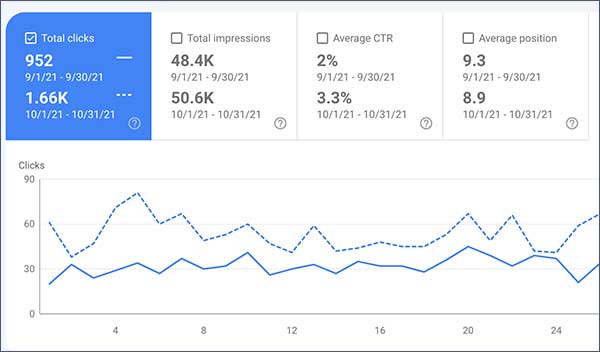Striking Distance Keywords – What They Are and How to Use Them to Increase Organic Traffic
Utilizing striking distance keywords is a great way to see a quick, easy rankings & organic traffic bump.
It’s some of your lowest hanging fruit in SEO, because it usually only requires minor tweaks on your existing content for potentially large SEO payouts – They allow you to harness the full potential of your existing content.
Keep reading, because this step-by-step guide is going to show you exactly how I use this method to skyrocket the traffic of my clients’ pages.
What are striking distance keywords?
Striking distance keywords are keywords that you are currently ranking for on existing content, but they are not as high up in the SERPS as they potentially could be.
They could be hovering toward the bottom of the first page, or on the 2nd or 3rd page.
The idea around striking distance keywords is that since you are already ranking for them, you could potentially bump their ranks with just a few minor tweaks to your existing on-page SEO.
A step-by-step guide to finding & optimizing striking distance keywords
Here’s exactly what you need to do to optimize for striking distance keywords:
- Identify your striking distance keywords
- Qualify & choose the best ones to target
- Optimize your content for the striking distance keywords
- Assess the performance of your campaign
Step 1: Identify your striking distance keywords
The first step is to find the keywords on your website that are hovering within striking distance.
*This requires an SEO tool that scans the rankings of a website, such as Ahrefs or Semrush
- Check all the ranking keywords of your website using your SEO tool of choice. (i.e. Ahref’s “Organic keywords” feature, Semrush’s “Keyword positions” feature, or Moz’s, “Keyword explorer”)
- Sort the list of ranking in order from best to worst rank
- Export your keywords that are ranked from position 8 to 20 (this range encompasses keywords ranked from bottom of the first page to the bottom of the second page. It is an arbitrary range that you may modify based on your current rankings and competition levels – i.e. positions 4-10 if you want to find opportunities to rank the top 3, or positions 11-30 if you want to find opportunities to rank first page, etc.)
You now have a list of your website’s keywords that are ranked within striking distance.
Step 2: Qualify & choose the best ones to target
Now that you have a list of keywords ranked within striking distance, we need to sift through the noise and select one or several of them that present the greatest opportunity.
The main benefit of the striking distance keyword method is that you are leveraging your existing content to find keyword long tail opportunities that you weren’t even necessarily trying to rank for initially.
Specifically, the perfect striking distance keyword phrases will meet all or some of these criteria:
1. You have not already targeted and optimized that exact keyword phrase
2. The keyword phrase is long-tail
3. The keyword phrase is low competition and easy to rank
4. The keyword phrase has decent search volume (>10 searches/mo)
Hypothetical example “best shoes”
Say I find out that a page on my website titled & targeting “best shoes” is ranking #8 for “best athletic shoes for wide feet”.
That page briefly mentions athletic shoes and wide feet, but it was not an initial keyword target of mine, thus there is room for improvement in terms of on-page optimization.
The search phrase is also long-tail, relatively low competition, and contains search volume.
This is the perfect long tail keyword to target since it meets all 4 of the criteria for a desirable target.
Step 3: Optimize your content for the striking distance keywords
Now that you have identified the perfect striking distance keyword or set of keywords, the hard part is done.
Now its back to the basics of on-page SEO. Look for places to add content to the existing article centered around your secondary target long-tail keyword.
Places you can add this keyword are:
An H2
The body text
An image alt
The meta description
*In this case, this is a secondary target. We still want to keep the primary, more competitive target as defined by your page title, meta title, and H1. For this reason, I wouldn’t suggest modifying those sections.
*If you don’t think your long-tail keyword meets the intent of the searcher and it would be better-served on its own new page, thats another option for utilizing a striking distance keyword opportunity. You could create an entirely new page targeting that keyword, rather than optimizing an existing page.
If you create your own separate page to target the striking distance keyword, put it in your:
Page title
Meta title
H1
Body copy
Url
Back to the shoe example
Remember from the previous example, I identified a striking distance keyword phrase on my “best shoes” article as “best athletic shoes for wide feet”.
Time to get-to-optimizing.
In my specific example, let’s say my article contains one instance of the keyword phrase “athletic shoes” and one instance of “wide feet” in the body copy. And just from that, its ranking #8. How do I get it to #1?
What I would do in this scenario is add an H2 section titled “Best Athletic Shoes”. I would then include “best athletic shoes for wide feet” in the body copy.
You don’t want to interrupt the flow of the article though. Another thing I could do is create an entirely separate article titled “10 Best Athletic Shoes for Wide Feet”. In this specific example, that may be a better route based on intent, search volumes, and competition levels.
If you write a separate article for your striking distance keyword, be sure to internally link from the existing page to the new page with anchor-rich text.
Step 4: Assess the performance of your campaign
You’ve done all the work, now what? It’s time to add the striking distance keyword as a tracked keyword, set it, and forget. Wait at least 1 month without touching the article. Check back to see your sweet SERP success.
What if nothing happened in a month? Don’t get discouraged. Wait another couple months, check back, and if there’s still no results, you need to modify your strategy.
If you didn’t see the results you hoped for, ask yourself:
Is my striking distance keyword too competitive?
Did I properly optimize it?
Does my article still match search intent?
Did I wait long enough to analyze the results?
After some pondering, refine your strategy. After all, that’s what SEO is all about.
Case study: A real-world striking distance example that I applied to one of our client’s pages to boost traffic 75%
Here’s how I applied that 4-step striking distance process to a client’s website.
I noticed that the client was ranking #8 for “colored contacts [city name]” on my page “Contact Lenses”. On this page, I was targeting “Contact Lenses [city name]” with no focus on “colored” contacts. In fact, I never even mentioned this product.
So I added an H2 for “Colored Contacts” with a little product description.
Several months later, I went from #8 for “Colored Contacts [city name]” to #1.
This resulted in a 74.37% traffic increase to that page:

Google Search Console organic click comparison chart, comparing the month of September (952 clicks) to the month of October (1,660 clicks), a 74.37% increase in organic traffic. The solid line illustrates September clicks, and the dotted line represents October clicks.
About 20 minutes of work resulted in almost doubling the traffic using the striking distance keywords optimization strategy.
The bottom line
Finding striking distance keywords is a unique way to conduct keyword research and leverage your existing rankings to give them a quick boost.
It is some of the lowest hanging fruit in SEO, and I suggest you give it a try today.
I am Ryan, founder of Clicked SEO. Have questions about implementing this strategy effectively? Contact me here.





